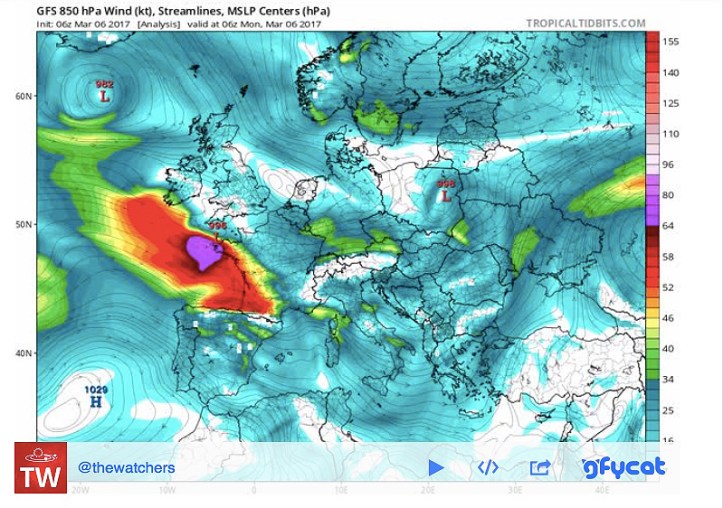 Pospoder lighthouse opposite Ouessant, photo Yves-Marie Quemener
Pospoder lighthouse opposite Ouessant, photo Yves-Marie Quemener
A month ago, Norwegian storm ”Thor” hit Sweden while its twin sister ”Gertrude” brought strong winds to Scotland and Northern England with a red warning for wind issued for the Shetland Islands where gusts of up to 105 mph were recorded, delays to road and rail and ferry networks and school closures were widespread.
A few days ago, ”weather bomb Doris” came in over Britain with gales and snow. Continuing to France, she changed her name to ”Zeus” and hit Brittany with hurricane-force winds. Yesterday, winds reaching 191 km/h (119 mph = 53 m/s) were recorded in Ouessant, 180 km/h (112 mph = 50 m/s) in l’Ile de Groix.
In the beginning, storms were given arbitrary names. An Atlantic storm that ripped the mast off a boat named Antje became known as Antje’s hurricane. Then, in the mid-1900s, people started using female names for storms.
Then, meteorologists decided to introduce a more organised and efficient system, taking names instead from a list arranged alphabetically. The first storm to occur in a year would be assigned a name beginning with A, and so on. Before the end of the 1900s, forecasters used male names for storms forming in the southern hemisphere.
Since 1953, storms in the Caribbean Sea, Gulf of Mexico and the North Atlantic have been named from lists drawn up by the National Hurricane Center. They are now maintained and updated by an international committee of the WMO. The original list featured only women’s names and in 1979, men’s names were introduced – and now they alternate each year. Six lists are used in rotation, so the list for 2016 will be used again in 2022.
When a storm is deemed to be particularly deadly or costly, its name is removed from the list. This is the case of Flora (1963), Gilbert (1988), Hugo (1989), and Andrew (1992). Another name is chosen to replace it at an annual meeting of the WMO Tropical Cyclone Committees.
There are no storms that begin with the less common letters Q, U, X, Y or Z.
Senator Sheila Jackson Lee from Texas argues that current hurricane names are too “lily white,” and is seeking to have better representation for names reflecting “African-Americans and other ethnic groups . All racial groups should be represented,” Lee says, hoping federal weather officials “would try to be inclusive of African-American names” such as Keisha, Jamal and Deshawn (http://www.wnd.com/2003/08/20096/#MFT1G46k7mZzIutH.99.
Meanwhile, ”Zeus” will exit into the Mediterranean Sea and rapidly deepen as it moves toward Italy. We have no records of what her Italian name will be.
 Weather map 8 of March 2017
Weather map 8 of March 2017
